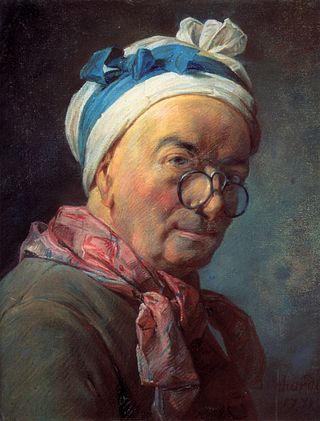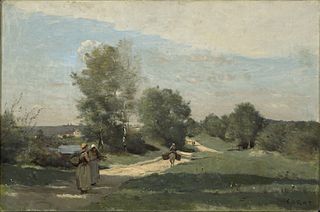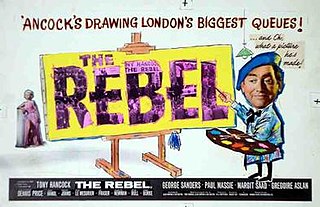Related Research Articles

Jean Siméon Chardin was an 18th-century French painter. He is considered a master of still life, and is also noted for his genre paintings which depict kitchen maids, children, and domestic activities. Carefully balanced composition, soft diffusion of light, and granular impasto characterize his work.

Paul Cézanne was a French Post-Impressionist painter whose work introduced new modes of representation and influenced avant-garde artistic movements of the early 20th century, whose work formed the bridge between late 19th-century Impressionism and early 20th century Cubism.

Pierre-Auguste Renoir was a French artist who was a leading painter in the development of the Impressionist style. As a celebrator of beauty and especially feminine sensuality, it has been said that "Renoir is the final representative of a tradition which runs directly from Rubens to Watteau."

John Singer Sargent was an American expatriate artist, considered the "leading portrait painter of his generation" for his evocations of Edwardian-era luxury. He created roughly 900 oil paintings and more than 2,000 watercolors, as well as countless sketches and charcoal drawings. His oeuvre documents worldwide travel, from Venice to the Tyrol, Corfu, Spain, the Middle East, Montana, Maine, and Florida.

Walter Richard Sickert was a German-born British painter and printmaker who was a member of the Camden Town Group of Post-Impressionist artists in early 20th-century London. He was an important influence on distinctively British styles of avant-garde art in the mid and late 20th century.

Visual art of the United States or American art is visual art made in the United States or by U.S. artists. Before colonization, there were many flourishing traditions of Native American art, and where the Spanish colonized Spanish Colonial architecture and the accompanying styles in other media were quickly in place. Early colonial art on the East Coast initially relied on artists from Europe, with John White the earliest example. In the late 18th and early 19th centuries, artists primarily painted portraits, and some landscapes in a style based mainly on English painting. Furniture-makers imitating English styles and similar craftsmen were also established in the major cities, but in the English colonies, locally made pottery remained resolutely utilitarian until the 19th century, with fancy products imported.

George Stubbs was an English painter, best known for his paintings of horses. Self-trained, Stubbs learnt his skills independently from other great artists of the 18th century such as Reynolds and Gainsborough. Stubbs' output includes history paintings, but his greatest skill was in painting animals, perhaps influenced by his love and study of anatomy. His series of paintings on the theme of a lion attacking a horse are early and significant examples of the Romantic movement that emerged in the late 18th century. He enjoyed royal patronage. His painting Whistlejacket hangs in the National Gallery, London.

The Barbizon school of painters were part of an art movement toward Realism in art, which arose in the context of the dominant Romantic Movement of the time. The Barbizon school was active roughly from 1830 through 1870. It takes its name from the village of Barbizon, France, on the edge of the Forest of Fontainebleau, where many of the artists gathered. Most of their works were landscape painting, but several of them also painted landscapes with farmworkers, and genre scenes of village life. Some of the most prominent features of this school are its tonal qualities, color, loose brushwork, and softness of form.

John Maler Collier was a British painter and writer. He painted in the Pre-Raphaelite style, and was one of the most prominent portrait painters of his generation. Both of his marriages were to daughters of Thomas Henry Huxley. He was educated at Eton College, and he studied painting in Paris with Jean-Paul Laurens and at the Munich Academy starting in 1875.

Kitchen sink realism is a British cultural movement that developed in the late 1950s and early 1960s in theatre, art, novels, film and television plays, whose protagonists usually could be described as "angry young men" who were disillusioned with modern society. It used a style of social realism which depicted the domestic situations of working-class Britons, living in cramped rented accommodation and spending their off-hours drinking in grimy pubs, to explore controversial social and political issues ranging from abortion to homelessness. The harsh, realistic style contrasted sharply with the escapism of the previous generation's so-called "well-made plays".

The Rebel is a 1961 British satirical comedy film directed by Robert Day and starring Tony Hancock. It was written by Ray Galton and Alan Simpson. The film concerns the clash between bourgeois and bohemian cultures.

Jean-Joseph Benjamin-Constant, born Jean-Joseph Constant, was a French painter and etcher best known for his Oriental subjects and portraits.
Carel Victor Morlais Weight, was an English painter.

Charles Joshua Chaplin was a French painter and printmaker who painted both landscapes and portraits. He worked in techniques such as pastels, lithography, watercolor, chalk, oil painting and etching. He was best known for his elegant portraits of young women.

Nick Miller is an Irish contemporary artist who has become known for reinvigorating painting and drawing in the traditional genres of portraiture, landscape and still-life. He has developed an intense and individual approach to the practice of working directly from life, that has been described as a form of encounter painting.

Humphrey Ocean is a contemporary British painter.

An animal painter is an artist who specialises in the portrayal of animals.

Fauvism is a style of painting and an art movement that emerged in France at the beginning of the 20th century. It was the style of les Fauves, a group of modern artists whose works emphasized painterly qualities and strong colour over the representational or realistic values retained by Impressionism. While Fauvism as a style began around 1904 and continued beyond 1910, the movement as such lasted only a few years, 1905–1908, and had three exhibitions. The leaders of the movement were André Derain and Henri Matisse.

James Peter Quinn was an Australian portrait painter born in Melbourne.

Jean Esme Oregon Cooke RA was an English painter of still lifes, landscapes, portraits and figures. She was a lecturer at the Royal Academy and regularly exhibited her works, including the summer Royal Academy exhibitions. She was commissioned to make portraits by Lincoln College and St Hilda's College, Oxford. Her works are in the National Gallery, Tate and the Royal Academy collections. In the early years of her marriage, she signed her works Jean Bratby.
References
- 1 2 3 4 5 Roberta Smith (23 July 1992). "John Bratby Is Dead; 'Kitchen Sink' Artist and a Novelist, 64". The New York Times. Retrieved 6 January 2014.
- ↑ 117 artworks by or after John Bratby , Art UK
- 1 2 3 4 5 6 7 8 9 Ian Chilvers; John Glaves-Smith (2009). A Dictionary of Modern and Contemporary Art. Oxford University Press. p. 259. ISBN 978-0-19-923965-8.
- 1 2 3 4 "John Bratby 1928–1992". Tate. Retrieved 6 January 2014.
- ↑ Rutherford, Paul. When Television Was Young. University of Toronto Press, 1990.
- ↑ "Kill To Get Crimson". MarkKnopfler.com. Archived from the original on 23 June 2018. Retrieved 23 June 2018.
- ↑ "John Bratby". Royal Academy of Arts.
- ↑ portrait of Paul McCartney, 1967 by John Bratby (unfinished background) | http://thegilly.tumblr.com/post/20518793459/john-bratbys-painting-of-paul-mccartney-1967
- ↑ "Pretty Boy Paul McCartney portrait goes on sale", Evening Standard, 16 September 2010.
- ↑ portrait of Paul McCartney and Flowers, 1967 by John Bratby | https://www.artuk.org/discover/artworks/paul-mccartney-and-flowers-22003
- ↑ John Bratby (1960). Breakdown. London: Hutchinson.
- ↑ John Bratby (1962). Brake Pedal Down. London: Hutchinson.
- 1 2 "Jean Cooke". The Telegraph. Telegraph Media Group Limited. 22 August 2008. Retrieved 5 January 2014.
- 1 2 "Jean Cooke: Painter of wit and subtlety". The Independent. independent.co.uk. 11 August 2008. Retrieved 5 January 2014.
- 1 2 Philip Vann (28 August 2008). "Jean Cooke, obituary". The Guardian. Retrieved 6 January 2014.
- ↑ "Jean Cooke: a painter". The Times. 14 August 2008. Retrieved 6 January 2014.
- ↑ "Baby in pram in garden, 1956, John Bratby". Walker Art Gallery, National Museums Liverpool. Archived from the original on 7 January 2014. Retrieved 6 January 2014.
- ↑ "Three Self Portraits with a White Wall, John Bratby". Walker Art Gallery, National Museums Liverpool. Archived from the original on 7 January 2014. Retrieved 6 January 2014.